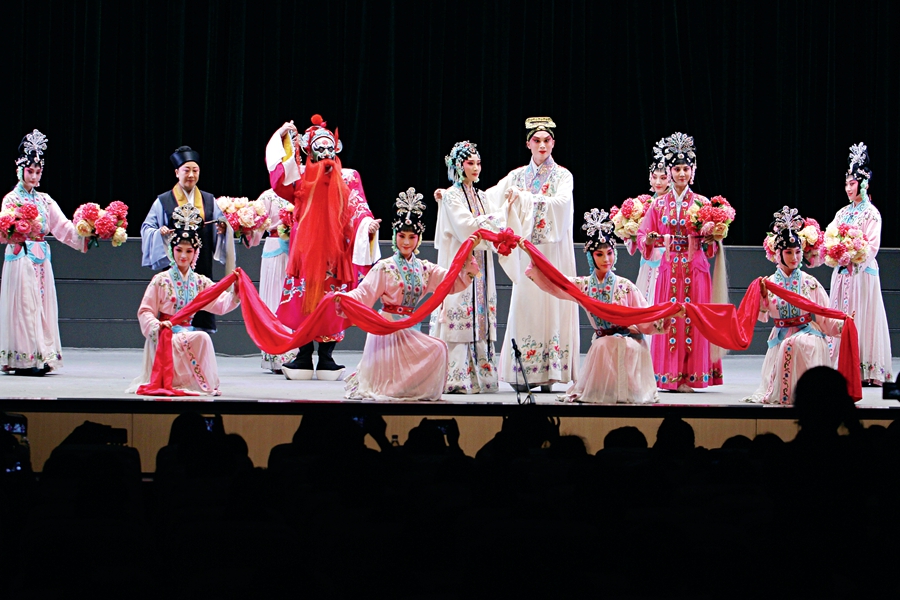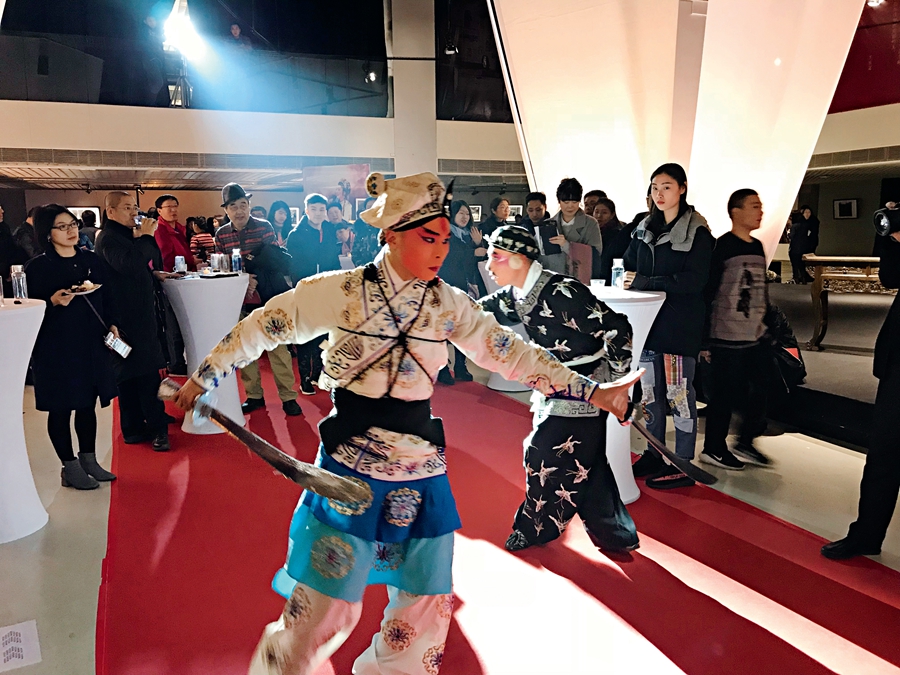By staff reporter LI YUAN
By staff reporter LI YUAN
WRITER and cultural researcher Yu Qiuyu wrote in his Where Does the Flute Melody Go: “If a culture has fascinated a nation for a long time, it must be one that reaches deep into the national psyche. Several cultural fetishes with large followings emerged after Chinese culture and arts matured. The first are the Tang Dynasty poems, the second calligraphy, and the third, in my view, is the Kunqu Opera.”
Kunqu Coming to Lincoln Center
Hao Meng studied Kunqu Opera for four years at the National Academy of Chinese Theatre Arts, but didn’t start her career in this field after graduation. She was drawn back to the art after an incident in the U.S.
While visiting her brother, who was studying in the U.S., Hao Meng attended a party with some of his friends. For most of the time, they talked about a thesis her brother recently published in a professional journal. The language and academic barriers kept Hao Meng out of their conversation, which made her feel like an outsider.
Then her brother turned to her: “Hao Meng, sing a passage of Kunqu for us.” She hesitated, as the opera genre only has a small group of lovers even in China. She was not sure how would it be perceived by foreign ears? At the encouragement of her brother, she performed a segment of The Peony Pavilion, and to her surprise, received warm applause from his American friends.

The Peony Pavilion is a masterpiece of Ming Dynasty playwright Tang Xianzu.
Days later at the Yellowstone National Park, Hao was impressed and inspired by local people’s efforts to protect the local elk population. “The 600-year-old Kunqu only has 600 or so professional players today. Doesn’t something of such cultural significance deserve more efforts to preserve it?” She thought to herself.
The oldest musical drama in China, Kunqu is called the mother of all Chinese operas, many of which have borrowed from or modeled themselves after it. Kunqu’s influence waxed and waned in past centuries, but it has remained the standard-bearer for Chinese theatre arts, with unparalleled refinement of libretto, melody, choreography, and the subtle sentiments they convey. In 2001, it was proclaimed a Masterpiece of the Oral and Intangible Heritage of Humanity by UNESCO.
When Hao Meng disclosed her intention to launch a project to preserve Kunqu, not all her friends were optimistic. “Do you think there is ‘rigid demand’ for the opera in a society of market economy?” Some asked. “Not everyone sees self-confidence as a rigid demand,” she replied. Eventually her friends and former schoolmates were convinced.
Last November, Hao founded the Belt and Road Kunqu Opera Theatre, which was inaugurated at a cultural industry forum in Beijing. Yang Fengyi, vice chairperson of China Theatre Association and president of Northern Kunqu Opera Theatre, hailed it as an innovative move of recruiting social forces in preserving and promoting this ancient art.
The newborn theater drew support from the cultural circle, investors, Kunqu educators, and foreign diplomats as well. “This testifies to the charm of Kunqu and the ardor of the general public to preserve and promote it,” said Hao Meng. At the forum, she received a special prize from Kevin Lee, chair of the Sino-American Cultural Organization, and was invited to perform at the Lincoln Center this year.
Modern Adaptation
On December 31, 2017, the Belt and Road Kunqu Opera Theatre gave its first performance – a part of The Peony Pavilion – in Beijing. The play is a masterpiece of Ming Dynasty playwright Tang Xianzu (1550 -1616), and has generated numerous iterations. What set Hao’s rendition apart from others is its stage lighting and setting.
Hao Meng was an assistant to director Zhang Yimou for the opening and closing ceremonies of the Beijing Olympic Games in 2008, and also for the Italian opera Turandot staged in the National Stadium, colloquially known as the Bird’s Nest, in 2009. The experience of working with Zhang opened her eyes to incorporating elements of Chinese culture into stage setting.
For “A walk in the Garden” and “The Interruption of a Dream,” a well-known act of The Peony Pavilion, Hao and her team employed modern video and lighting technologies to create a multi-layered effect and an ink painting illusion, which was well received by the audience. “The modernist setting gives new life to a classical play,” commented a female viewer.
“Traditional Chinese operas like Kunqu should not end up in the museum,” said Han Ziyong, head of the management center of the China National Arts Fund. “The defining trait of arts is sharing. Traditional operas must pinpoint the best way to survive and thrive in modern times, reconciling old-time cultural genes with present-day tastes, or it will lose vitality for long-term development.”

Artists perform Peking Opera acrobatics close to the audience.
The audience is critical in the preservation of any opera, and needs to be educated and cultivated. At the theater’s debut, Hao Meng offered her audience an immersive experience – a display of sumptuous costumes and props situated around the doorway leading to the room of the stage. While observing these items close up, theatregoers could listen to staff members expounding on each one’s function and connotation. There was also a section of shadow play (an ancient form of storytelling and entertainment which uses flat articulated cut-out figures, called shadow puppets, which are held between a source of light and a translucent screen), where live performance was given, and the puppet making technique was demonstrated.
This immersive ambience continued throughout the opera, with the cast performing very close to the audience, and taking questions from them at intervals. The night was also punctuated by a suona (a horn-like woodwind instrument) performance by Zhous’ Band, which is now in the seventh generation, and Peking Opera acrobatics.
Concerning her thoughts behind this design, Hao said, “Artists should take the pulse of cultural heritage, and adopt innovative and technology-enhanced methods. More regard should be given to the audience’s participation and experience, and making the performance more interactive to win their hearts. In this way, the participants will truly fall for traditional culture, inculcate stronger confidence in it, and feel the urge to protect it.”
Appealing to Today’s Audiences
Hao’s remake of “A walk in the Garden” and “The Interruption of a Dream” stars several celebrated Kunqu artists, and has received broad attention in the opera circle. She and her team are refining the play in preparation for an international tour.
The Belt and Road Kunqu Opera Theatre has a staff of two dozen who are all trained opera artists in their 30s. “Opera players are hardworking, and have a strong sense of teamwork. In schools, we were repeatedly told to see ourselves as a vegetable in the garden, meaning we must support each other on the stage. This spirit is critical for a young team like ours,” Hao said. Her team shares the goal of reviving the ancient art of Kunqu.
For the first step, they collected dossiers of the Qing Dynasty (1644-1911) performance authorities, which included 11,498 plays staged for the royal family and general public during the time, along with records of props and costumes. In collaboration with Peking University and experts from other institutions, the theatre hopes to bring some very old plays back onto the stage. “There is a lot of work to be done, such as rewriting the play in modern Chinese, and modifying the plots to fit with the current social context,” Hao said. Many scholars and artists have shown interest in this project.
The Belt and Road Kunqu Opera Theatre also plans to develop new media formats of the opera, including cartoon, film, mobile phone game, and TV drama. However, Yang Fengyi, herself a senior Kunqu player, cautioned, “When promoting Kunqu internationally, we must be firmly grounded in native culture while developing a global vision. Chinese culture should stand its ground, and never make excessive concessions to pander to foreign cultures.” She spoke from her experience of performing abroad. “We have underestimated the aesthetic capacity of the foreign audience. People of different nations actually have similar perceptions of art.”
On this point, Hao agrees with Yang. “To revive Kunqu, we need innovative thinking. But innovation is in no way a subversion of tradition.” She opposes retrofitting foreign plays into Kunqu or reworking Kunqu into Western operas.
With the support of several diplomats, the Belt and Road Kunqu Opera Theater will perform in the U.S., Middle East, Africa, Latin America, and other Asian countries this year, presenting authentic Kunqu to local audiences and disseminating Chinese culture on the global arena.
“Every Chinese is a practitioner of the Chinese Dream, and every one of us is trying to find our position in life. Nothing is better than following one’s dream and doing what one likes to do,” Hao said.